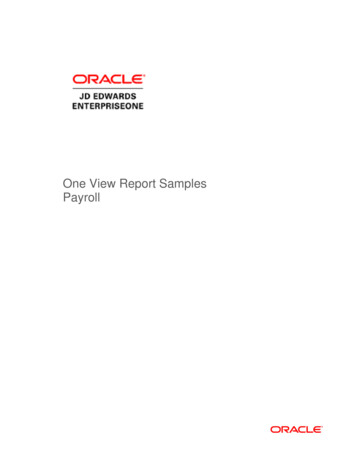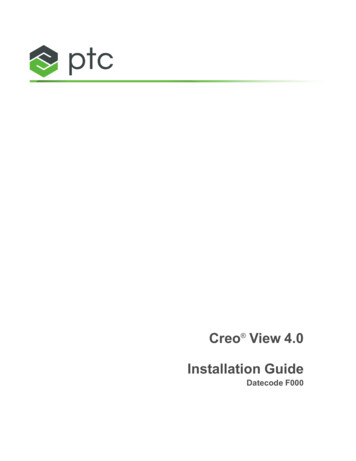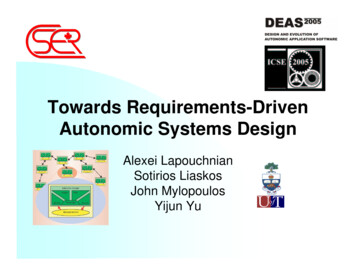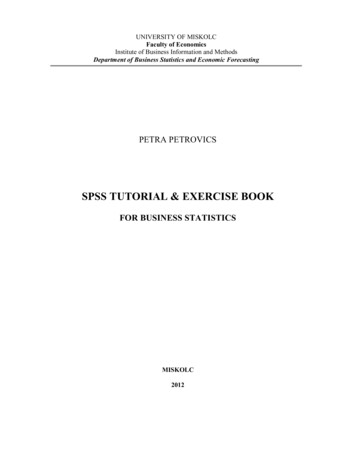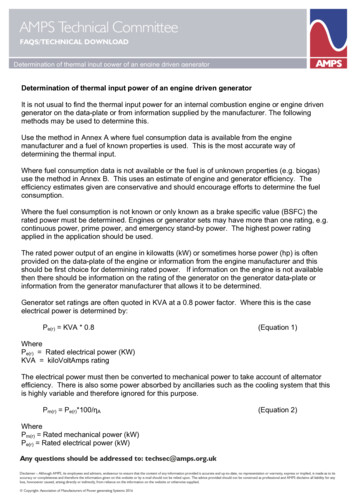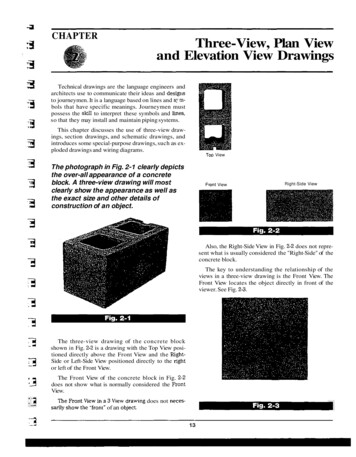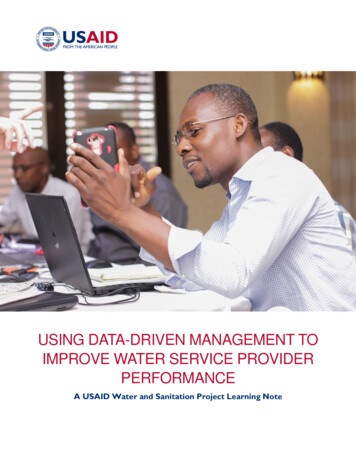
Transcription
A Data Quality-Driven View of MLOpsCedric Renggli† Luka Rimanic† Nezihe Merve Gürel† Bojan Karlaš† Wentao Wu‡ Ce Zhang††ETH Zurich‡Microsoft Research{cedric.renggli, luka.rimanic, nezihe.guerel, bojan.karlas, ctDeveloping machine learning models can be seen as a process similar to the one established for traditionalsoftware development. A key difference between the two lies in the strong dependency between the qualityof a machine learning model and the quality of the data used to train or perform evaluations. In thiswork, we demonstrate how different aspects of data quality propagate through various stages of machinelearning development. By performing a joint analysis of the impact of well-known data quality dimensionsand the downstream machine learning process, we show that different components of a typical MLOpspipeline can be efficiently designed, providing both a technical and theoretical perspective.1IntroductionA machine learning (ML) model is a software artifact “compiled” from data [24]. This point of view motivates astudy of both similarities and distinctions when compared to traditional software. Similar to traditional softwareartifacts, an ML model deployed in production inevitably undergoes the DevOps process — a process whose aimis to “shorten the system development life cycle and provide continuous delivery with high software quality” [6].The term “MLOps” is used when this DevOps process is specifically applied to ML [4]. Different from traditionalsoftware artifacts, the quality of an ML model (e.g., accuracy, fairness, and robustness) is often a reflection of thequality of the underlying data, e.g., noises, imbalances, and additional adversarial perturbations.Therefore, one of the most promising ways to improve the accuracy, fairness, and robustness of an MLmodel is often to improve the dataset, via means such as data cleaning, integration, and label acquisition. AsMLOps aims to understand, measure, and improve the quality of ML models, it is not surprising to see that dataquality is playing a prominent and central role in MLOps. In fact, many researchers have conducted fascinatingand seminal work around MLOps by looking into different aspects of data quality. Substantial effort has beenmade in the areas of data acquisition with weak supervision (e.g., Snorkel [29]), ML engineering pipelines (e.g.,TFX [25]), data cleaning (e.g., ActiveClean [27]), data quality verification (e.g., Deequ [40, 41]), interaction (e.g.,Northstar [26]), or fine-grained monitoring and improvement (e.g., Overton [30]), to name a few.Meanwhile, for decades data quality has been an active and exciting research area led by the data managementcommunity [7, 47, 37], having in mind that the majority of the studies are agnostic to the downstream MLmodels (with prominent recent exceptions such as ActiveClean [27]). Independent of downstream ML models,Copyright 2021 IEEE. Personal use of this material is permitted. However, permission to reprint/republish this material foradvertising or promotional purposes or for creating new collective works for resale or redistribution to servers or lists, or to reuse anycopyrighted component of this work in other works must be obtained from the IEEE.Bulletin of the IEEE Computer Society Technical Committee on Data Engineering11
Table 1: Overview of our explorations with data quality propagation at different stages of an MLOps process.Technical Problem for MLMLOps StageMLOps QuestionData Quality DimensionsData Cleaning (Sec. 3) [23]Feasibility Study (Sec. 4) [32]CI/CD (Sec. 5) [31]Model Selection (Sec. 6) [21]Pre TrainingPre TrainingPost TrainingPost TrainingWhich training sample to clean?Is my target accuracy realistic?Am I overfitting to val/test?Which samples should I label?Accuracy & CompletenessAccuracy & CompletenessTimelinessCompleteness & Timelinessresearchers have studied different aspects of data quality that can naturally be split across the following fourdimensions [7]: (1) accuracy – the extent to which the data are correct, reliable and certified for the task at hand;(2) completeness – the degree to which the given data collection includes data that describe the corresponding setof real-world objects; (3) consistency – the extent of violation of semantic rules defined over a set of data; and(4) timeliness (also referred to as currency or volatility) – the extent to which data are up-to-date for a task.Our Experiences and Opinions In this paper, weprovide a bird’s-eye view of some of our previousDataML Modelworks that are related to enabling different functionML Processalities with respect to MLOps. These works are intraining, validation, .spired by our experience working hand-in-hand withData Quality IssuesML Utilityacademic and industrial users to build ML applica- accuracy, completeness,accuracy, generalization,consistency, timelinessfairness, robustness, .tions [39, 48, 35, 46, 2, 38, 18, 19, 8, 36], togetherwith our effort of building ease.ml [3], a prototypeTechnical Question: How do different data qualitysystem that defines an end-to-end MLOps process.issues propagate through the ML process?Our key observation is that often MLOps challenges are bound to data management challenges — given theaforementioned strong dependency between the quality of ML models and the quality of data, the never-endingpursuit of understanding, measuring, and improving the quality of ML models, often hinges on understanding,measuring, and improving the underlying data quality issues. From a technical perspective, this poses uniquechallenges and opportunities. As we will see, we find it necessary to revisit decades of data quality researchthat are agnostic to downstream ML models and try to understand different data quality dimensions – accuracy,completeness, consistency, and timeliness – jointly with the downstream ML process.In this paper, we describe four of such examples, originated from our previous research [23, 32, 21, 31].Table 1 summarizes these examples, each of which tackles one specific problem in MLOps and poses technicalchallenges of jointly analyzing data quality and downstream ML processes.Outline In Section 2 we provide a setup for studying this topic, highlighting the importance of taking theunderlying probability distribution into account. In Sections 3-6 we revisit components of different stages of theease.ml system purely from a data quality perspective. Due to the nature of this paper, we avoid going into thedetails of the interactions between these components or their technical details. Finally, in Section 7 we describe acommon limitation that all the components share, and motivate interesting future work in this area.2Machine Learning PreliminariesIn order to highlight the strong dependency between the data samples used to train or validate an ML model andits assumed underlying probability distribution, we start by giving a short primer on ML. In this paper we restrictourselves on supervised learning in which, given a feature space X and a label space Y, a user is given accessto a dataset with n samples D : {(xi , yi )}i [n] , where xi X and yi Y. Usually X Rd , in which casea sample is simply a d-dimensional vector, whereas Y depends on the task at hand. For a regression task one12
usually takes Y R, whilst for a classification task on C classes one usually assumes Y {1, 2, . . . , C}. Werestrict ourselves to classification problems.Supervised ML aims at learning a map h : X Y that generalizes to unseen samples based on the providedlabeled dataset D. A common assumption used to learn the mapping is that all data points in D are sampledidentically and independently (i.i.d.) from an unknown distribution p(X, Y ), where X, Y are random variablestaking values in X and Y, respectively. For a single realisation (x, y), we abbreviate p(x, y) p(X x,Y y).The goal is to choose h(·) H, where H represents the hypothesis space, that minimizes the expected riskwith respect to the underlying probability distribution [44]. In other words, one wants to construct h such thatZ Z h arg min EX,Y (L(h(x), y)) arg minL(h(x), y)p(x, y) dy dx,(1)h Hh HXYwith L(ŷ, y) being a loss function that penalizes wrongly predicted labels ŷ. For example, L(ŷ, y) 1(ŷ y)represents the 0-1 loss, commonly chosen for classification problems. Finding the optimal mapping h is notfeasible in practice: (1) the underlying probability p(X, Y ) is typically unknown and it can only be approximatedusing a finite number of samples, (2) even if the distribution were known, calculating the integral is intractable formany possible choices of p(X,P Y ). Therefore, in practice one performs an empirical risk minimization (ERM) bysolving ĥ arg minh H n1 ni 1 L(h(xi ), yi ). Despite the fact that the model is learned using a finite numberof data samples, the ultimate goal is to learn a model which generalizes to any sample originating from theunderlying probability distribution, by approximating its posterior p(Y X). Using ĥ to approximate h canrun into what-is-known as “overfitting” to the training set D, which reduces the generalization property of themapping. However, advances in statistical learning theory managed to considerably lower the expected risk formany real-world applications whilst avoiding overfitting [15, 52, 44]. Altogether, any aspect of data quality forML application development should not only be treated with respect to the dataset D or individual data pointstherein, but also with respect to the underlying probability distribution the dataset D is sampled from.Validation and Test Standard ML cookbooks suggest that the data should be represented by three disjointsets to train, validate, and test. The validation set accuracy is typically used to choose the best possible set ofhyper-parameters used by the model trained on the training set. The final accuracy and generalization propertiesare then evaluated on the test set. Following this, we use the term validation for evaluating models in thepre-training phase, and the term testing for evaluating models in the post-training phase.Bayes Error Rate Given a probability distribution p(X, Y ), the lowest possible error rate achievable by anyclassifier is known in the literature as the Bayes Error Rate (BER). It can be written as RX,Y EX 1 max p(y x) ,(2)y Yand the map hopt (x) arg maxy Y p(y x) is called the Bayes Optimal Classifier. It is important to note that,even though hopt is the best possible classifier (that is often intractable for the reason stated above), its expected risk might still be greater than zero, which results in the accuracy being at most 1 RX,Y. In Section 4, we willoutline multiple reasons and provide examples for a non-zero BER.Concept Shift The general idea of ML described so far assumes that the probability distribution P (X, Y )remains fixed over time, which is sometimes not the case in practice [53, 51, 17]. Any change of distributionover time is known as a concept shift. Furthermore, it is often assumed that both the feature space X and labelspace Y remain identical over a change of distribution, which could also be false in practice. A change of X orp(X) (marginalized over Y ) is often referred to as a data drift, which can result in missing values for training orevaluating a model. We will cover this specific aspect in Section 3. When a change in p(X) modifies p(Y X),13
Figure 1: Illustration of the relation between Certain Answers and Certain Predictions [23]. On the right, Q1represents a checking query, whereas Q2 is a counting query.this is known as a real drift or a model drift, whereas when p(Y X) stays intact it is a virtual drift. Fortunately,virtual drifts have little to no impact on the trained ML model, assuming one managed to successfully approximatethe posterior probability distribution over the entire feature space X .3MLOps Task 1: Effective ML Quality OptimizationOne key operation in MLOps is seeking a way to improve the quality (e.g., accuracy) of a model. Apart fromtrying new architectures and models, improving the quality and quantity of the training data has been knownto be at least as important [28, 14]. Among many other approaches, data cleaning [20], the practice of fixing orremoving noisy and dirty samples, has been a well-known strategy for improving the quality of data.MLOps Challenge When it comes to MLOps, a challenge is that not all noisy or dirty samples matter equallyto the quality of the final ML model. In other words – when “propagating” through the ML training process, noiseand uncertainty of different input samples might have vastly different effects. As a result, simply cleaning the inputdata artifacts either randomly or agnostic to the ML training process might lead to a sub-optimal improvementof the downstream ML model [28]. Since the cleaning task itself is often performed “semi-automatically” byhuman annotators, with guidance from automatic tools, the goal of a successful cleaning strategy from an MLOpsperspective should be to minimize the amount of human effort. This typically leads to a partially cleaned dataset,with the property that cleaning additional training samples would not affect the outcome of the trained model (i.e.,the predictions and accuracy on a validation set are maintained).A Data Quality View A principled solution to the above challenge requires a joint analysis of the impact ofincomplete and noisy data in the training set on the quality of an ML model trained over such a set. Multipleseminal works have studied this problem, e.g., ActiveClean [27]. Inspired by these, we introduced a principledframework called CPClean that models and analyzes such a noise propagation process together with principledcleaning algorithms based on sequential information maximization [23].14
Our Approach: Cleaning with CPClean CPClean directly models the noise propagation — the noises andincompleteness introduce multiple possible datasets, called possible worlds in relational database theory, and theimpact of these noises to final ML training is simply the entropy of training multiple ML models, one for each ofthese possible worlds. Intuitively, the smaller the entropy, the less impactful the input noise is to the downstreamML training process. Following this, we start by initiating all possible worlds (i.e., possible versions of thetraining data after cleaning) by applying multiple well-established cleaning rules and algorithms independentlyover missing feature values. CPClean then operates in multiple iterations. At each round, the framework suggeststhe training data to clean that minimizes the conditional entropy of possible worlds over the partially clean dataset.Once a training data sample is cleaned, it is replaced by its cleaned-up version in all possible worlds. At its core,it uses a sequential information-maximization algorithm that finds an approximate solution (to this NP-Hardproblem) with theoretical guarantees [23]. Calculating such an entropy is often difficult, whereas in CPClean weprovide efficient algorithms which can calculate this term in polynomial time for a specific family of classifiers,namely k-nearest-neighbour classifiers (kNN).This notion of learning over incomplete data using certain predictions is inspired by research on certainanswers over incomplete data [1, 49, 5]. In a nutshell, the latter reasons about certainty or consistency of theanswer to a given input, which consists of a query and an incomplete dataset, by enumerating the results over allpossible worlds. Extending this view of data incompleteness to non-relational operator (e.g., an ML model) is anatural yet non-trivial endeavor, and Figure 1 illustrates the connection.Limitations Taking the downstream ML model into account for prioritizing human cleaning effort is not new.ActiveClean [27] suggests to use information about the gradient of a fixed model to solve this task. Alternatively,our framework relies on consistent predictions and, thus, works on an unlabeled validation set and on MLmodels that are not differentiable. In [23] we use kNN as a proxy to an arbitrary classifier, given its efficientimplementation despite exponentially many possible worlds. However, it still remains to be seen how to extendthis principled framework to other types of classifiers. Moreover, combining both approaches and supporting alabor-efficient cleaning approach for general ML models remains an open research problem.4MLOps Task 2: Preventing Unrealistic ExpectationsIn DevOps practices, new projects are typically initiated with a feasibility study, in order to evaluate and understandthe probability of success. The goal of such a study is to prevent users with unrealistic expectations from spendinga lot of of money and time on developing solutions that are doomed to fail. However, when it comes to MLOpspractices, such a feasibility study step is largely missing — we often see users with high expectations, but with avery noisy dataset, starting an expensive training process which is almost surely doomed to fail.MLOps Challenge One principled way to model the feasibility study problem for ML is to ask: Given anML task, defined by its training and validation sets, how to estimate the error that the best possible ML modelcan achieve, without running expensive ML training? The answer to this question is linked to a traditionalML problem, i.e., to estimate the Bayes error rate (also called irreducible error). It is a quantity related tothe underlying data distribution and estimating it using finite amount of data is known to be a notoriously hardproblem. Despite decades of study [10, 16, 42], providing a practical BER estimator is still an open researchproblem and there are no known practical systems that can work on real-world large-scale datasets. One keychallenge to make feasibility study a practical MLOps step is to understand how to utilize decades of theoreticalstudies on the BER estimation and which compromises and optimizations to perform.Non-Zero Bayes Error and Data Quality Issues At the first glance, even understanding why the BER isnot zero for every task can be quite mysterious — if we have enough amount of data and a powerful ML model,15
Figure 2: ImageNet examples from the validation set illustrating possible reasons for a non-zero Bayes Error.Image (#6874) on the left illustrates a non-unique label probability, image (#4463) in the middle shows multipleclasses for a fixed sample, and image (#32040) on the right is mislabeled as a “pizza”.what would stop us from achieving perfect accuracy? The answer to this is deeply connected to data quality.There are two classical data quality dimensions that constitute the reasons for a non-zero BER: (1) completenessof the data, violated by an insufficient definition of either the feature space or label space, and (2) accuracy of thedata, mirrored in the amount of noisy labels. On a purely mathematical level, the reason for a non-zero BERlies in overlapping posterior probabilities for different classes, given a realisable input feature. More intuitively,for a given sample the label might not be unique. In Figure 2 we illustrate some real-world examples from thevalidation set of ImageNet [11]. For instance, the image on the left is labeled as a golfcart (n03445924) whereasthere is a non-zero probability that the vehicle belongs to another category, for instance a tractor (n04465501) –additional features can resolve such an issue by providing more information and thus leading to a single possiblelabel. Alternatively, there might in fact be multiple “true” labels for a given image. The center image showssuch an example, where the posterior of class rooster (n01514668) is equal to the posterior of the class peacock(n01806143), despite being only labeled as a rooster in the dataset – changing the task to a multi-label problemwould resolve this issue. Finally, having noisy labels in the validation set yields another sufficient condition fora non-zero BER. The image on the left shows such an example, where a pie is incorrectly labeled as a pizza(n07873807).A Data Quality View There are two main challenges in building a practical BER estimator for ML modelsto characterize the impact of data quality to downstream ML models: (1) the computational requirements and(2) the choice of hyper-parameters. Having to estimate the BER in today’s high-dimensional feature spacesrequires a large amount of data in order to give a reasonable estimate in terms of accuracy, which results in a highcomputational cost. Furthermore, any practical estimator should be insensitive to different hyper-parameters, asno information about the data or its underlying distribution is known prior to running the feasibility study.Our Approach: ease.ml/snoopy We design anovel BER estimation method that (1) has no hyperparameters to tune, as it is based on nearest-neighborestimators, which are non-parametric; and (2) usespre-trained embeddings, from public sources such asPyTorch Hub or Tensorflow Hub1 , to considerablydecrease the dimension of the feature space. The aforementioned functionality of performing a feasibility study using ease.ml/snoopy is illustrated in the abovefigure. For more details we refer interested readers to both the full paper [32] and the demo paper for this1https://pytorch.org/hub and https://tfhub.dev16
component [33]. The usefulness and practicality of this novel approach is evaluated on well-studied standard MLbenchmarks through a new evaluation methodology that injects label noise of various amounts and follows theevolution of the BER [32]. It relies on our theoretical work [34], in which we furthermore provide an in-depthexplanation for the behavior of kNN over (possibly pre-trained) feature transformations by showing a cleartrade-off between the increase of the BER and the boost in convergence speed that a transformation can yield.Limitations The standard definition of the BER assumes that both the training and validation data are drawni.i.d. from the same distribution, an assumption that does not always hold in practice. Extending our work to asetup that takes into account two different distributions for training and validation data, for instance as a directconsequence of applying data programming or weak supervision techniques [29], offers an interesting line offuture research, together with developing even more practical BER estimators for the i.i.d. case.5MLOps Task 3: Rigorous Model Testing Against OverfittingOne of the major advances in running fast and robust cycles in the software development process is known ascontinuous integration (CI) [12]. The core idea is to carefully define and run a set of conditions in the form oftests that the software needs to successfully pass every time prior to being pushed into production. This ensuresthe robustness of the system and prevents unexpected failures of production code even when being updated.However, when it comes to MLOps, the traditional way of reusing the same test cases repeatedly can introduceserious risk of overfitting, thus compromise the test result.MLOps Challenge In order to generalize to the unknown underlying probability distribution, when trainingan ML model, one has to be careful not to overfit to the (finite) training dataset. However, much less attentionhas been devoted to the statistical generalization properties of the test set. Following best ML practices, theultimate testing phase of a new ML model should either be executed only once per test set, or has to be completelyobfuscated from the developer. Handling the test set in one way or the other ensures that no information of thetest set is leaked to the developer, hence preventing potential overfitting. Unfortunately, in ML developmentenvironments it is often impractical to implement either of these two approaches.A Data Quality View Adopting the idea of continuously testing and integrating ML models in productionshas two major caveats: (1) test results are inherently random, due to the nature of ML tasks and models, and (2)revealing the outcome of a test to the developer could mislead them into overfitting towards the test set. The firstaspect can be tackled by using well-established concentration bounds known from the theory of statistics. To dealwith the second aspect, which we refer to as the timeliness property of testing data, there is an approach pioneeredby Ladder [9], together with the general area of adaptive analytics (cf. [13]), that enable multiple reuses of thesame test set with feedback to the developers. The key insight of this line of work is that the statistical power ofa fixed dataset shrinks when increasing the number of times it is reused. In other words, requiring a minimumstatistically-sound confidence in the generalization properties of a finite dataset limits the number of times that itcan be reused in practice.Our Approach: Continuous Integration of ML Models with ease.ml/ci As part of the ease.mlpipeline, we designed a CI engine to address both aforementioned challenges. The workflow of the systemis summarized in Figure 3. The key ingredients of our system lie in (a) the syntax and semantics of the testconditions and how to accurately evaluate them, and (b) an optimized sample-size estimator that yields a budget oftest set re-uses before it needs to be refreshed. For a full description of the workflow as well as advanced systemoptimizations deployed in our engine, we refer the reader to our initial paper [31] and the followup work [22],which further discusses the integration into existing software development ecosystems.17
Figure 3: The workflow of ease.ml/ci, our CI/CD engine for ML models [31].We next outline the key technical details falling under the general area of ensuring generalization propertiesof finite data used to test the accuracy of a trained ML model repetitively.Test Condition Specifications A key difference between classical CI test conditions and testing ML modelslies in the fact that the test outcome of any CI for ML engine is inherently probabilistic. Therefore, when evaluatingresult of a test condition that we call a score, one has to define the desired confidence level and tolerance as an( , δ) requirement. Here (e.g., 1%) indicates the size of the confidence interval in which the estimated scorehas to lie with probability at least 1 δ (e.g., 99%). For instance, the condition n - o 0.02 /- 0.01requires that the new model is at least 2 points better in accuracy than the old one, with a confidence interval of 1point. Our system additionally supports the variable d that captures the fraction of different predictions betweenthe new and old model. For testing whether a test condition passes or fails one needs to distinguish two scenarios.On one hand, if the score lies outside the confidence interval (e.g., n - o 0.03 or n - o 0.01),the test immediately passes or fails. On the other hand, the outcome is ill-defined if the score lies inside theconfidence interval. Depending on the task, user can choose to allow false positive or false negative results (alsoknown as “type I” and “type II” errors in statistical hypothesis testing), after which all the scores lying inside theconfidence interval will be automatically rejected or accepted.Test Set Re-Uses In the case of a non-adaptive scenario in which no information is revealed to the developerafter running the test, the least amount of samples needed to perform H evaluations with the same dataset is thesame as running a single evaluation with δ/H error probability, since the H models are independent. Therefore,revealing any kind of information to the developer would result in a dataset of size H multiplied by the numberof samples required for one evaluation with δ/H error. However, this trivial strategy is very costly and usuallyimpractical. The general design of our system offers a different approach that significantly reduces the amount oftest samples needed for using the same test set multiple times. More precisely, after every commit the systemonly reveals a binary pass/fail signal to the developer. Therefore, there are 2H different possible sequences ofpass/fail responses, which yields that the number of samples needed for H iterations is the same as running asingle iteration with δ/2H error probability – much smaller than the previous δ/H one. We remark that furtheroptimizations can be deployed by making use of the structure or low variance properties that are present in certaintest conditions, for which we refer the interested readers to the full paper [31].Limitations The main limitation consists of the worst-case analysis which happens when the developer acts asan adversarial player that aims to overfit towards the hidden test set. Pursuing other, less pragmatic approaches tomodel the behavior of developers could enable further optimization to reduce the number of test samples neededin this case. A second limitation lies in the lack of ability to handle concept shifts. Monitoring a concept shiftcould be thought of as a similar process of CI – instead of fixing the test set and testing multiple models, one18
could fix a single model and test its generalization over multiple test sets. From that perspective, we hope thatsome of the optimizations that we have derived in our work could potentially be applied to monitoring conceptshifts as well. Nevertheless, this needs further study and forms an interesting research path for the future.6MLOps Task 4: Efficient Continuous Quality TestingOne of the key motivations for DevOps principles in the first place is the ability to perform fast cycles andcontinuously ensure the robustness of a system by quickly adapting to changes. At the same time, both arewell-known requirements from traditional software development that naturally extend to the MLOps world. Onechallenge faced by many MLOps practitio
software development. A key difference between the two lies in the strong dependency between the quality of a machine learning model and the quality of the data used to train or perform evaluations. In this work, we demonstrate how different aspects of data quality propagate through various stages of machine learning development.
